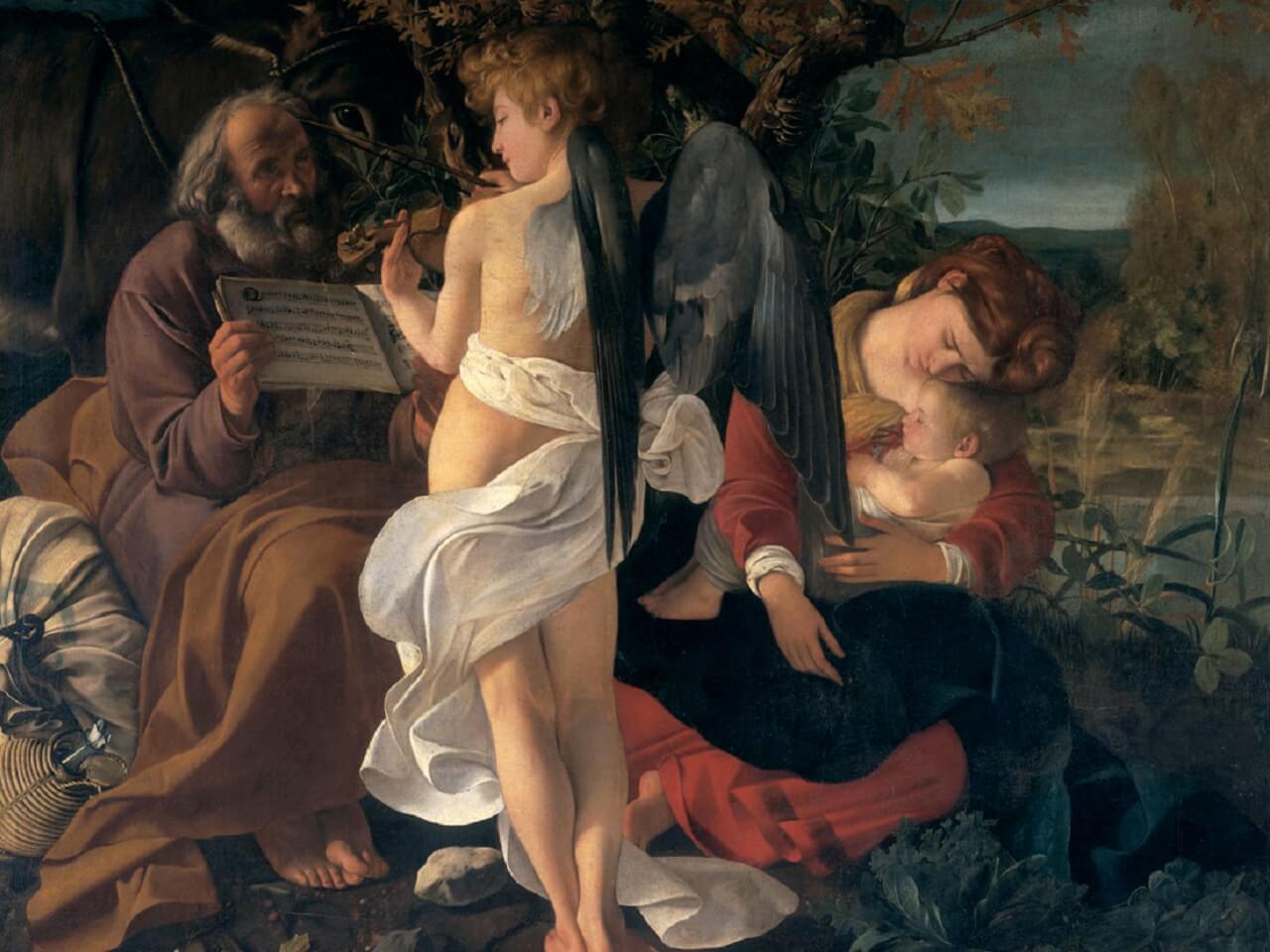On July 18, 410 years ago, 1610, occurred the death of Caravaggio, byname of Michelangelo Merisi (1571–1610), at the age of only 38. He died in Porto d’Ercole, Tuscany, while he was trying to return to Rome. Called the “cursed” painter in the nineteenth century, he was in love with reality as it is and with light as the bursting in of the divine saving grace.
Disease and several escapes from one city to another (with stops in Naples, Malta, Syracuse, Messina, Palermo, and then again in Naples) marked his short life, along with a rich production of high-quality works.
Let’s approach the artist in our usual way: through passion for music, admiring in particular the Rest on the Flight into Egypt, or The Madonna goes into Egypt, as it was then called, a picture for a chamber, painted by a young Caravaggio around 1597 and kept in the Galleria Doria Pamphilj, Rome. Also in this work, the great Lombard maestro’s profound religiosity and a far from approximate and amateurish knowledge of the things of music are felt.
In his best known work, the art historian Giovanni Pietro Bellori tells us, Caravaggio “painted the Madonna resting on the Flight into Egypt; here there is a standing angel who plays the violin, and saint Joseph, seated, holds a book of music open for him; the angel is very beautiful, and by turning his head in sweet profile, displays his winged shoulders and the rest of his nude body, which is covered by a little drapery. On the other side sits the Madonna, who, with her head inclined, seems asleep with her baby at her breast” (G.P. Bellori, Lives of Caravaggio, Los Angeles The J. Paul Getty Museum 2019, pp. 66–68).
The painter paints on the basis of the evangelist Matthew, who tells us of the escape of the Holy Family to Egypt to avoid Herod’s persecution: “When they [the Magi] had departed, behold, the angel of the Lord appeared to Joseph in a dream and said, ‘Rise, take the child and his mother, flee to Egypt, and stay there until I tell you. Herod is going to search for the child to destroy him.’” Joseph rose and took the child and his mother by night and departed for Egypt. He stayed there until the death of Herod, that what the Lord had said through the prophet might be fulfilled, ‘Out of Egypt I called my son’” (Mt. 2:13–15; cfr. Hos. 11:1).
The whole canvas refers to the Song of Songs, the poem of Christ’s love for the Church, whose author, “employing comparisons from conjugal affection, describes symbolically the bonds of mutual love by which God and his chosen people are united to each other” (Pius XII, Haurietis aquas, May 15, 1956, n. 28). Caravaggio follows the teaching of Rupert of Deutz, a 12th-century Benedicine monk, who was the first to make a Marian exegesis of the Song of Songs, identifying the bride with Mary Most Holy. The Madonna’s red hair recalls Ct. 7:6: “your hair is like purple; a king is caught in its locks.” Our Lady’s sleep refers to Ct. 5:2: “I was sleeping, but my heart was awake.”
A beautiful angel from behind, who plays the violin, divides the scene of Joseph’s and Mary’s halt during the flight to Egypt, depicted by Caravaggio and set by him in the Roman countryside: on the right is the Blessed Virgin Mary, asleep with the Child Jesus sleeping on her knees; on the left is the glorious Saint Joseph, who, although elderly and tired of the journey, remains awake and holds the score for the angel.
What music comes from the violin? Not a generic lullaby that sweetens the dreams of the Madonna and Child, but a specific polyphonic choral composition with a sacred subject, which two historians recognized in 1983 in the score, read by the angel and held by the glorious patriarch, which doesn’t include the lyrics: Quam pulchra es, a motet composed around 1520 by the French-Flemish composer Noël Bauldewijn, which sings some verses of chapter 7 of the Song of Songs (F.T. Camiz a A. Ziino, Caravaggio: aspetti musicali e committenza, in Studi musicali 12, 1983, pp. 67–83). We read in the first part of the text, of which Caravaggio paints the initial letter “Q” (Ct. 7): “Quam pulchra es et quam decora, / Assimilata es palmæ / et ubera tua botris. / Caput tuum ut Carmelus / collus tuus sicut turris eburnea”, “How beautiful you are, how fair! / Your very form resembles a date-palm, / and your breasts, clusters. / Your head rises upon you like Carmel; / your neck like a tower of ivory.” And the second part (12–13), of which the initial letter “V” is seen in the canvas, says: “Veni, dilecte mi, egrediamur; / si flores fructum parturierunt, / si floruerunt mala punica / tibi dabo ubera mea. Amen,” “Come, my lover, let us go out. / If the buds have opened, if the pomegranates have blossomed / will I give my love (literally: “I will give you my breasts.”). Amen.”
Together with St. Joseph, who, “secluded, shares in the divine love of the Spouses from another sphere and shows the score, which sings the praises of them” (M. Calvesi, Riposo durante la fuga in Egitto, in C. Strinati, Caravaggio, Skira, Milano 2010, pp. 39-40), let us too be kidnapped by so much beauty, by the text of the Song of Songs, and by the angel’s music. Enjoy!


